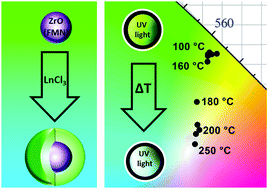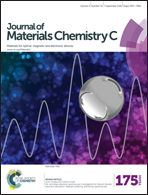White light emission and temperature dependent chromaticity shifts by modification of luminescent ZrO(FMN) nanoparticles with rare earth halides†
Abstract
The photoluminescence of the dispersions of zirconyl flavinmononucleotide nanoparticles (ZrO[FMN]: FMN = flavinmononucleotide) in pyridine was deliberately influenced by the addition of rare earth halides LnCl3, resulting in a modification to core/shell structures with the nanoparticle as the core. The particle dispersion's original intense green luminescence of the flavin chromophore can therefore be shifted in chromaticity from green via white to blue. The shift depends on the reaction conditions as well as on the rare earth halide. Heating of the systems during the modification initiates these chromaticity shifts and they remain even after cooling to room temperature. For Ln = Y, La and Ho, all three halides can be used to create a broad band white light emission with a high general colour rendering index (CRI) of 84–88. The colour shift starts at 180 °C for Y and La, whereas HoCl3 addition already approaches the white point at 200 °C, whereas unmodified dispersions of ZrO(FMN) do not show a chromaticity shift at this temperature. The La-modified dispersion requires 250 °C to emit white light. The luminescence of the modified nanoparticles is also temperature dependent upon cooling to low temperatures, which shifts the colour point to intense blue for Y and La at −196 °C. Determination of the photoluminescence lifetimes indicates the modification of the chromophore and no solvent participation.

- This article is part of the themed collection: 2016 Journal of Materials Chemistry C Hot Papers

 Please wait while we load your content...
Please wait while we load your content...